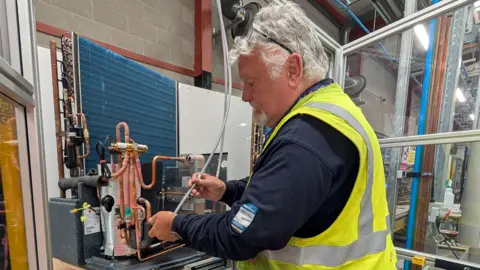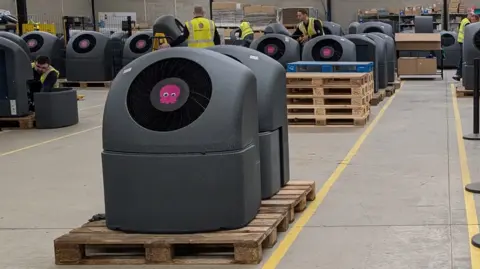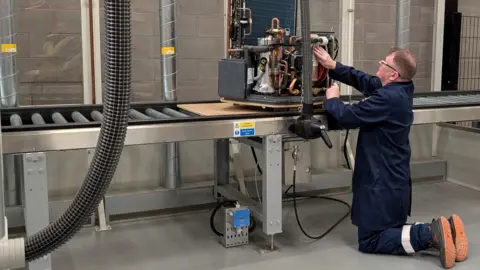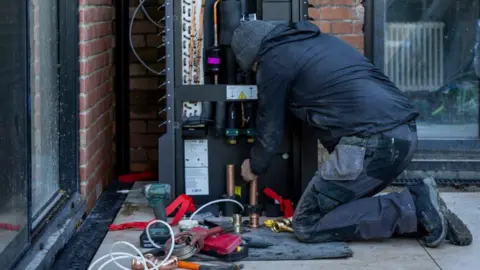Technology Reporter
 Chris Baraniuk
Chris BaraniukOn the day I visit Octopus Energy’s heat pump factory in Craigavon, Northern Ireland, temperatures in London reached 29C.
Some of the staff meeting me, who are usually based in the south of England, are beaming. It’s wonderful to escape the heat, they say.
And who can blame them. Climate change is making the UK hotter. In order to do something about that, decarbonising our energy systems – including domestic heating – is becoming more and more urgent.
Heat pumps run on electricity, not oil or gas, and Octopus is manufacturing heat pumps of its own design right here in Northern Ireland.
“It kind of gets harder as you go up – it’s like levels in a game,” says Patrick Doran, one of the workers here, after I view the production line.
He’s referring to how, in just under a year, he’s completed training in each stage of the manufacturing process.
From fitting pipework to attaching bundles of cables, which connect up the heat pump’s internal electronics. “I get to do something different every day,” enthuses Doran.
The government wants to see 600,000 heat pumps going in to UK homes annually by 2028, just three years away.
While installations have quickened recently, the country remains far behind that target. Total UK heat pump sales were slightly below 100,000 in 2024.
Demand for heat pumps boomed in Europe when gas prices spiralled following Russia’s invasion of Ukraine in 2022 – but that enthusiasm has since cooled.
Gas has become slightly cheaper again meaning that heat pumps are finding it harder to compete against gas boilers in terms of running costs.
This factory, in a medium-sized warehouse, can churn out 600 heat pumps per month, I’m told – and this will soon double when a second production line becomes active.
And in principle, Octopus could introduce additional shifts here and make many times that number of units. If higher demand materialises.
“We can have a plug-and-play solution that works in the majority of homes in the UK,” says Aimee Clark, head of commercial, as she explains why Octopus wanted to manufacture its own heat pump – which is unusual among electricity providers, to say the least.
 Chris Baraniuk
Chris BaraniukOther heat pump makers, including Vaillant, have UK manufacturing sites. And Copeland, which makes heat pumps components, has a factory here in Northern Ireland. It supplies compressors to Octopus.
Heat pumps work by absorbing heat from the environment, usually the air. It’s a way of harvesting free heat, if you like.
Ambient heat causes a refrigerant inside the heat pump to warm up and expand. A compressor squeezes that refrigerant, raising its temperature yet further.
Finally, a heat exchanger transfers this heat to water that gets pumped around your radiators, for instance.
The Octopus heat pumps sport an unusual design. They come in a dark grey plastic casing. I have to admit, to me, it looks a little bit dour – but it packs some original tech.
Mateusz Dewhurst, director of manufacturing, points out an internal metal plate the company has patented – refrigerant flows through this plate, absorbing heat from the machine’s electronics and cooling them down. “That’s a performance gain,” says Mr Dewhurst.
He also says the heat pump’s casing contains small grey insulation beads to reduce heat loss from the system. Exactly the same kind of beads that are sometimes used to insulate cavity walls in buildings, he explains.
 Chris Baraniuk
Chris BaraniukHeat pump technology has been around since the 1800s.
Zhiwei Ma at Durham University says manufacturing these devices is relatively straightforward – he made one himself when he was a PhD student.
“It worked fine,” he recalls. Companies such as Octopus are able to buy in the main components and assemble a finished product. “There’s very little room to improve anything,” argues Dr Ma.
Octopus would perhaps disagree. They say their design choices make a difference to overall performance, which the firm can track thanks to the many heat and pressure sensors it secretes within the device.
Heat pumps can produce multiple kilowatts of heat for every kilowatt of electricity they consume, a ratio known as their co-efficient of performance (Cop). Ensuring the Cop is as high as possible really matters in terms of keeping running costs low.
Octopus technicians can intervene should data from a heat pump’s sensors indicate a severe dip in performance. And customers also get an overview of their heat pump’s efficiency via a smartphone app.
 Getty Images
Getty ImagesEnsuring that heat pumps are installed competently is paramount, says Steven Metcalf at the University of Warwick. He and colleagues occasionally work with Mitsubishi, which has a heat pump factory in Scotland.
“It could be the difference of a Cop of 2.5 versus 4 – your bills will scale with that,” he explains. “It can be a huge penalty for getting a bad install.”
Public acceptance of heat pumps rests on people having confidence that switching to such a system won’t turn out to be a massive headache – though it’s worth saying that, in other countries such as colder Norway, heat pumps have long been embraced by locals.
Octopus says surveys of its customers suggest a majority find their heat pump costs the same or less than their old gas boiler, and provides heat that is just as comfortable if not more so.
Taxing fossil fuels harder is one way to spur demand for domestic appliances that use electricity as an alternative, says Paul Kenny, director general of the European Heat Pump Association, an industry body.
“Right now what we have is factories that are at low capacity factors, they’re idle or running well below what they could be running,” he says, referring to the slackening demand for heat pumps in Europe at present.
There could also be greater consistency regarding subsidies.
Despite having the highest proportion of especially-polluting oil heating systems of any UK nation, Northern Ireland is the only region within the UK or Ireland that doesn’t have a widely available grant to reduce the cost of a heat pump installation.
I point out the irony, therefore, of making heat pumps here to TJ Root, Octopus’s Cosy program director, after my factory tour. “It’s incredibly ironic,” he agrees.




